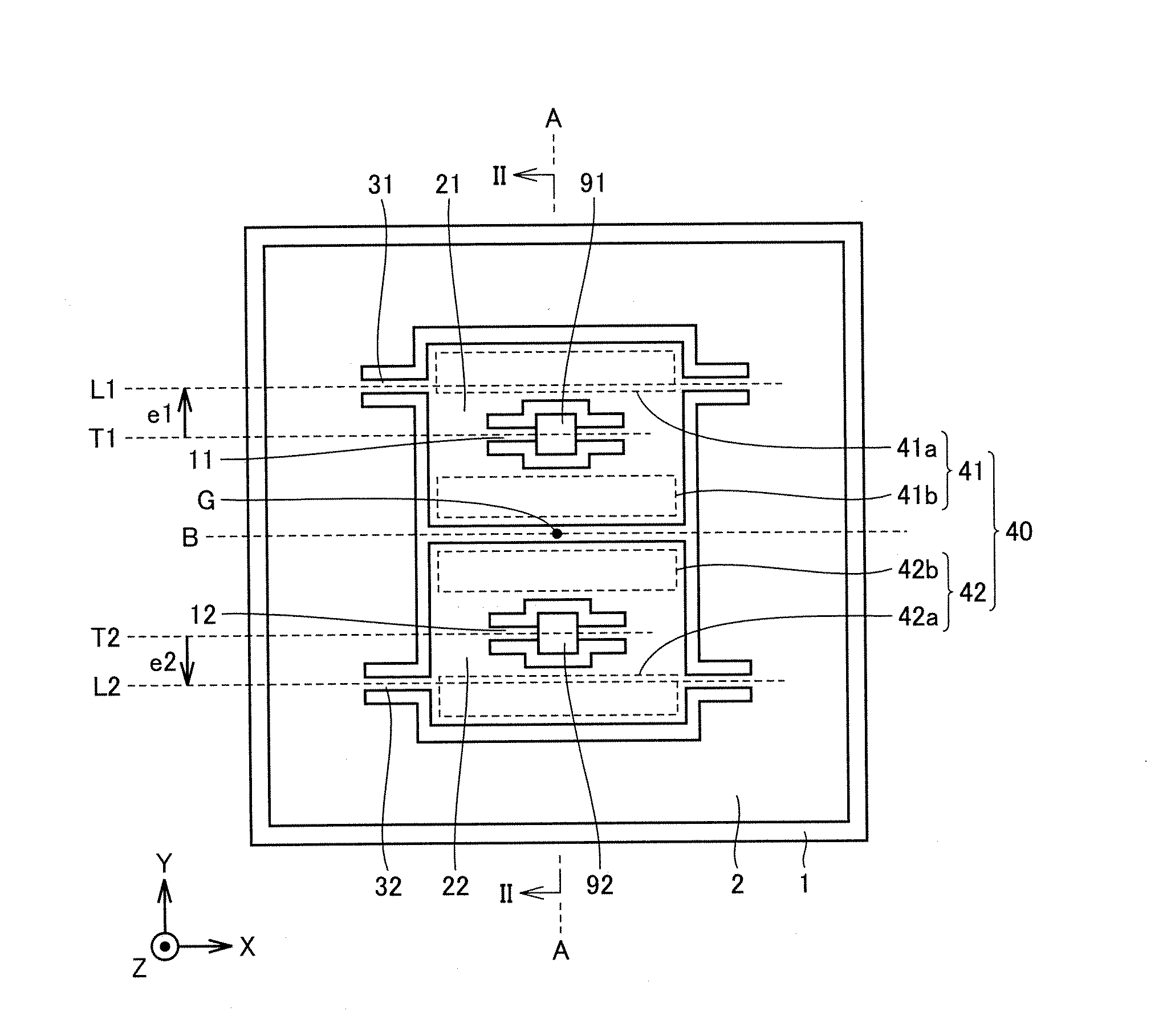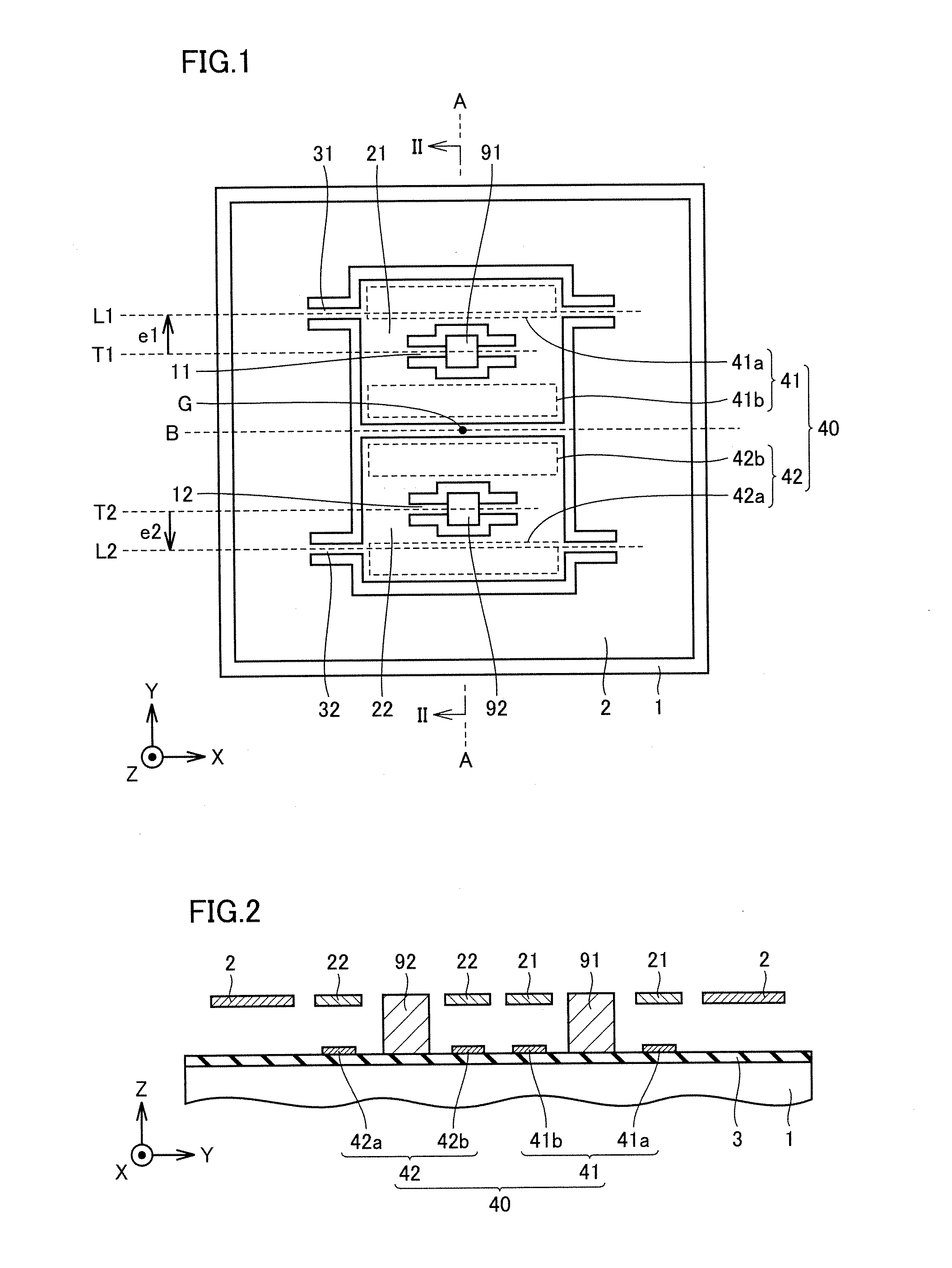Acceleration sensor
- Summary
- Abstract
- Description
- Claims
- Application Information
AI Technical Summary
Benefits of technology
Problems solved by technology
Method used
Image
Examples
embodiment 1
[0052]First, a main constitution of an acceleration sensor according to the present embodiment is explained.
[0053]Referring to FIGS. 1 and 2, the coordinate axes of the X axis, the Y axis and the Z axis are introduced for convenience of explanation. In FIG. 1, the X axis is an axis in which the right direction along the lateral direction is the positive direction, the Y axis is an axis in which the upper direction along the longitudinal direction is the positive direction, and the Z axis is an axis which is vertical to the paper surface and in which the upper direction is the positive direction. Note that the direction of the Z axis coincides with the acceleration direction to be measured by the acceleration sensor according to the present embodiment.
[0054]The acceleration sensor according to the present embodiment mainly includes a substrate 1, first and second torsion beams 11 and 12, first and second detection frames 21 and 22, a plurality of detection electrodes 40, first and se...
embodiment 2
[0102]Referring to FIGS. 14 and 15, in an acceleration sensor according to the present embodiment, an actuation electrode 5 is formed on substrate 1 so as to face inertia mass body 2.
[0103]Note that since the constitution other than this part is the same as the above described constitution of Embodiment 1, the same components are denoted by the same reference numerals and characters, and the explanation of the components is omitted.
[0104]According to the present embodiment, as shown by the arrow shown in FIG. 15, electrostatic force pulling inertia mass body 2 toward substrate 1 can be generated by applying a voltage between actuation electrode 5 and inertia mass body 2. That is, inertia mass body 2 can be electrostatically driven in the film thickness direction of substrate 1. This electrostatic drive makes it possible to generate the displacement of inertia mass body 2 equivalent to the displacement in the case where acceleration az in the film thickness direction of substrate 1 i...
embodiment 3
[0105]Referring to FIG. 16, an acceleration sensor according to the present embodiment includes anchors 90 on substrate 1 and supporting beams 4.
[0106]One end part of supporting beam 4 is supported above substrate 1 by anchor90. Further, the other end part of supporting beam 4 supports inertia mass body 2.
[0107]Supporting beam 4 has a first supporting beam 4X and a second supporting beam 4Y. First supporting beam 4X has a shape which can be easily elastically deformed in the Z axis direction and hardly elastically deformed in the X axis direction. Second supporting beam 4Y has a shape which can be easily elastically deformed in the Z axis direction and hardly elastically deformed in the Y axis direction. For this reason, supporting beam 4 as a whole has a constitution which can be easily elastically deformed in the Z axis direction and hardly elastically deformed in the XY in-plane direction.
[0108]Note that since the constitution other than this part is the same as the above describ...
PUM
 Login to View More
Login to View More Abstract
Description
Claims
Application Information
 Login to View More
Login to View More - R&D
- Intellectual Property
- Life Sciences
- Materials
- Tech Scout
- Unparalleled Data Quality
- Higher Quality Content
- 60% Fewer Hallucinations
Browse by: Latest US Patents, China's latest patents, Technical Efficacy Thesaurus, Application Domain, Technology Topic, Popular Technical Reports.
© 2025 PatSnap. All rights reserved.Legal|Privacy policy|Modern Slavery Act Transparency Statement|Sitemap|About US| Contact US: help@patsnap.com



